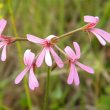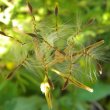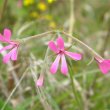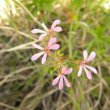Pelargonium alchemilloides
| Botanical Name | Pelargonium alchemilloides |
|||||||||||
| Family | Geraniaceae - The geranium family. |
|||||||||||
| Pronunciation | pe-lar-GO-nee-um al-ke-mil-OH-id-eez |
|||||||||||
| Common Name(s) |
English: Lady's Mantle-leaf Pelargonium; Garden Geranium
Afrikaans: Malva; Wildemalva
IsiXhosa: Inkubele
IsiZulu: Inkubele; Ishwaqa; Umangqengqe
Sesotho: Bolila-ba-litsoene
siSwati: inkubele; ishwaqa; umangqengqe
|
|||||||||||
| Plant Group |
|
|||||||||||
| Plant Size |
|
|||||||||||
| Position |
|
|||||||||||
| General Information |
|
|||||||||||
| Specific Information | Pelargonium alchemilloides is a low, sprawling plant up to 20 cm in height with a woody rootstock and an underground tuber that can reportedly grow up to 6 m in length. The leaves, which form a central rosette, are usually 5-lobed, often with a purplish-brown to dark red horseshoe-shaped zonal marking and are sparsely covered with silky hairs. Leaves range in size from 20 - 70 mm in diameter, are irregularly toothed and highly variable in shape. The straggly flowering stems are slender and covered with long hairs. Seeds are held in the distinctive 'crane’s bill' arrangement of all pelargoniums. The plant seeds prolifically and as the seeds are distributed by wind, will be found germinating over quite a large area away from the mother plant. The plant may be deciduous in cold or very dry areas but will remain evergreen if it has sufficient water. |
|||||||||||
| Ad Break | ||||||||||||
| Flowers | ||||||||||||
| Description | small pelargonium flowers held at end of a long thin stem in an umbrella-like cluster |
|||||||||||
| Season |
|
|||||||||||
| Colour |
|
|||||||||||
| Growth Rate |
|
|||||||||||
| Plant Uses |
|
|||||||||||
| Distribution and Habitat | widespread in the Western Cape, Eastern Cape, KwaZulu-Natal, Mpumalanga, Free State, Gauteng, Limpopo and North West provinces, as well as in Lesotho, Swaziland, Mozambique and Zimbabwe and throughout tropical east and north-east Africa to Ethiopia and Somalia |
|||||||||||
| Planting Suggestions | Pelargonium alchemilloides is best planted from seed. Plant direct or in a seed tray in any well drained medium, cover lightly and keep moist. Transplant when big enough to handle. Tolerates a wide variety of soils, habitats and positions. Water occasionally if necessary, but this is a truly water wise plant needing little care. |
|||||||||||
| Lorraine's Garden Notes | This pelargonium grows vigorously in the veld around Bathurst and in my wild garden and makes frequent forays into my formal gardens. Besides being sprawling and untidy, I do not encourage it to take hold as I am certain that given a chance it will become invasive. The smaller plant with the leaf markings (see pics.) comes from a wetter area of the country and is more delicate, preferring shade and moisture. (I am in fact not entirely certain that it is P. alchemilloides but it has all the characteristics). |
|||||||||||
| Medicinal Uses | Medicinally used for fever, diarrhoea and wounds. |
|||||||||||
| Ad Break | ||||||||||||










Discuss this plant
Share knowledge, ask a question or give an experience.